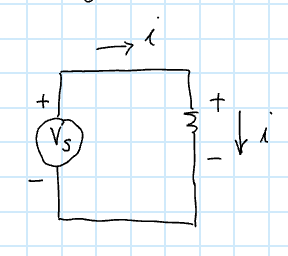Current
Current if the flow of electrons. It is given by:
where is the charge (number of electrons). Current is given in units of amperes A.
Voltage
Energy is required to move a charge between two points in a circuit. The work per unit charge required to do this is called voltage. The unit of voltage is the volt (V), which is defined to be one joule per coulomb. The voltage difference between two points in a circuit is a measure of the energy required to move charge from one point to the other
Direction of Current
Positive current is defined to go:
- From to in a circuit
- From to in a battery

Power
Power generated, dissipated, or stored by a circuit element equals the product of the voltage difference across the element and the current flowing through the element:
Governing Laws
- Kirchoff’s Current Law (Conservation of Charge): The algebraic sum of currents at any node is zero.
- Kirchoff’s Voltage Law (Conservation of Energy): The algebraic sum of voltage across elements in a loop is zero.
Passive Elements
Resistors
When a current flows through wire or other circuit elements, it encounters resistance. Sometimes this resistance is desirable and intentionally introduced; a resistor is an element designed to provide resistance, such that there is a linear relation between the current passing through them and the voltage difference across them:
The power dissipated by a resistor is given by
Parallel resistors:
For parallel resistors, we should note that:
where and are the currents flowing through and respectively.
Series resistors:
Capacitors
A capacitor is designed to store charge. The capacitance of a capacitor is a measure of how much charge can be stored for a given voltage difference across the element:
Thus, we also have:
which gives:
Capacitors store electrical energy as stored charge:
Inductor
A magnetic field (a flux) surrounds a moving charge or current. If the conductor of the current is coiled, the flux created by the current in one loop affects the adjacent loops. This flux is proportional to the time integral of the applied voltage, and the current is proportional to the flux.
The relation for an inductor is , where is the inductance and is the flux across the inductor. We can re-arrange this as:
The relation between flux and voltage is
Combining the two relations above gives:
which is equivalent to
Inductors store electrical energy in a magnetic field, which can be expressed as: